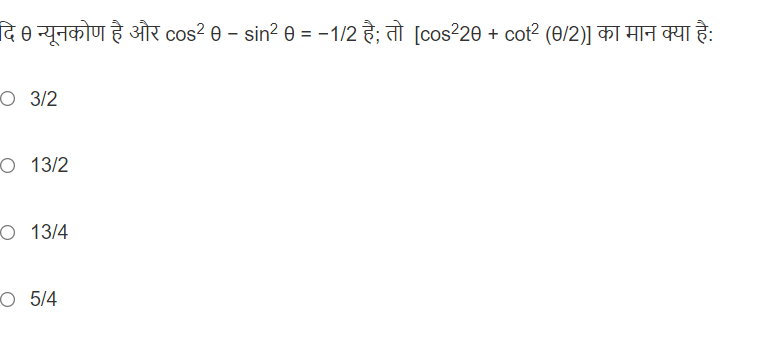यदि θ न्यूनकोण है और cos² θ - sin² θ = -1/2 है, तो [cos² 2θ + cot² (θ/2)] का मान क्या है?

Understand the Problem
यह प्रश्न त्रिकोणमितीय समीकरण को हल करने और दिए गए व्यंजक का मान ज्ञात करने के बारे में है। यहाँ, हमें दिया गया है कि cos² θ - sin² θ = -1/2 है, और हमें [cos² 2θ + cot² (θ/2)] का मान ज्ञात करना है।
Answer
$\frac{13}{4}$
Answer for screen readers
$\frac{13}{4}$
Steps to Solve
- Simplify the given equation using trigonometric identity
We are given that $\cos^2 \theta - \sin^2 \theta = -\frac{1}{2}$. Using the trigonometric identity $\cos 2\theta = \cos^2 \theta - \sin^2 \theta$, we can rewrite the given equation as $$ \cos 2\theta = -\frac{1}{2} $$
- Solve for $\theta$
Since $\theta$ is an acute angle (न्यूनकोण), $0 < \theta < \frac{\pi}{2}$, which implies $0 < 2\theta < \pi$. We have $\cos 2\theta = -\frac{1}{2}$. The angle $2\theta$ in the interval $(0, \pi)$ that satisfies this condition is $2\theta = \frac{2\pi}{3}$. Therefore, $\theta = \frac{\pi}{3}$.
-
Calculate $\cos^2 2\theta$ $2\theta = \frac{2\pi}{3}$, so $4\theta = \frac{4\pi}{3}$. $$ \cos^2 2\theta = \cos^2 \left(\frac{2\pi}{3}\right) = \left(-\frac{1}{2}\right)^2 = \frac{1}{4} $$
-
Calculate $\cot^2 (\theta/2)$
Since $\theta = \frac{\pi}{3}$, we have $\frac{\theta}{2} = \frac{\pi}{6}$. Therefore, $$ \cot^2 \left(\frac{\theta}{2}\right) = \cot^2 \left(\frac{\pi}{6}\right) = (\sqrt{3})^2 = 3 $$
- Evaluate the expression $\cos^2 2\theta + \cot^2 (\theta/2)$
$$ \cos^2 2\theta + \cot^2 \left(\frac{\theta}{2}\right) = \frac{1}{4} + 3 = \frac{1}{4} + \frac{12}{4} = \frac{13}{4} $$
$\frac{13}{4}$
More Information
The final answer is $\frac{13}{4}$. We found this by using trigonometric identities and given information to find the value of $\theta$, and then substituting it into the expression to be evaluated.
Tips
- Forgetting trigonometric identities, especially $\cos 2\theta = \cos^2 \theta - \sin^2 \theta$.
- Incorrectly solving for $\theta$ or not considering the given range for $\theta$.
- Making mistakes while squaring terms.
AI-generated content may contain errors. Please verify critical information